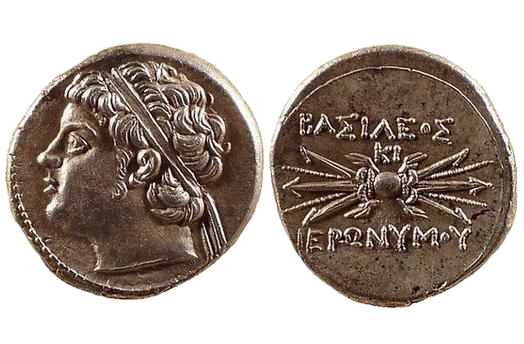
about ancient nomos
Ancient Nomos Art is a museum of galleries exhibiting ancient coins and ancient mint maps. The coin gallery displays the diverse art and history of hand-crafted ancient Greek, Roman, Byzantine, Persian and Medieval coinage. The ancient mints mapping gallery features Greek, Roman, Byzantine, Asia Minor and Medieval mint city regions and territories. Visitor's are welcome to explore, study and enjoy Ancient Nomos Art.

Greek, Syracuse – 215 BC
Hieronymos
From Ancient Galleries

Obverse: Diademed head of Hieronymos facing left wearing long curled sidelock.
Reverse: Center globe with winged thunderbolts and arrows, with Greek legends.
LEGEND SYMBOLS
Obv. Diademed head of King Hieronymos facing left. Rev. Winged thunderbolts between Greek inscriptions ΒΑΣΙΛΕΩΣ (King) and KI above, ΗΕΡΩΝΥΜΟΥ (Hieronymos) below.
The brief reign of the last Magna Grecian king of Syrakos (Syracuse), Hieronymos, began when he was a 15 year old boy. His reign followed the deaths of both his father Gelo and his reigning grandfather King Hieron II in 215 BC. His grandfather, Hieron II, reigned prior to Hieronymos and had famously allied Greek Syrakos with Roman Latins by signing post Messana War treaty with Rome in 265 BC. The treaty with Rome helped Syrakos defended itself from persistent attacks by Carthage. The treaty also maintained a peaceful relation between Rome and itself for the next fifty years. By the end of Hieron’s reign however, Rome and Carthage were again battling in what is known as the Second Punic War. After witnessing Rome losing to Hannibal’s invasions of north Italy in 218 BC and suffering the terrible defeat at Cannae in 216 BC, Gelo is thought to have influenced the young Hieronymos by his favoring the apparently stronger Hannabil of Carthage. Upon his succession, Hieronymos consequently courted Hannibal and met with his generals, Hippokrates and Epikydes, to negotiate an illfated alliance between Syrakos and Carthage. When Hieronymos repudiated Rome and failed to reaffirm Hieron’s Messana treaty, a pro-Roman faction in Syrakos plotted and successfully assassinated Hieronymos while he was visiting Leontini of Sicily, in 214 BC. His reign and coinage lasted just thirteen months. Few examples of his rare coinage exist and even fewer of this exceedingly rare 5 litra denomination. The obverse coin above depicts a diademed bust Hieronymos facing left in a classic idealized Greek portrait style. The coins reverse depicts the symbolic winged thunderbolt with arrow heads emerging from a central sphere. This image is attributed to the Greek god Zeus and is a sign of power, strength and vitality. Unfortunately, following the death of Hieronymos, Syrakos was captured, looted and destroyed by the Romans. Syrakos (Syracuse) was reduced to a minor provincial town, marking the end of its glorious 500-year history as a magnificent independent Greek City-State.
DOCUMENTATION
Value: 5 Litra. Metal: AR Silver. Weight: 4.20 grams. Mint: Syracuse. Date: after 215 BC.
Attribution: Holloway, “Thirteen Month Coinage of Hieronymos” 51, (same dies); BAR Issue 80; SNG ANS; BMC 221 (same dies); Hirsch 746 (same dies); CNG Triton XIII, 1042 (same dies); Weber, Plate 67, 1718 (10 Litra).
Legend, Documentation and Attribution
